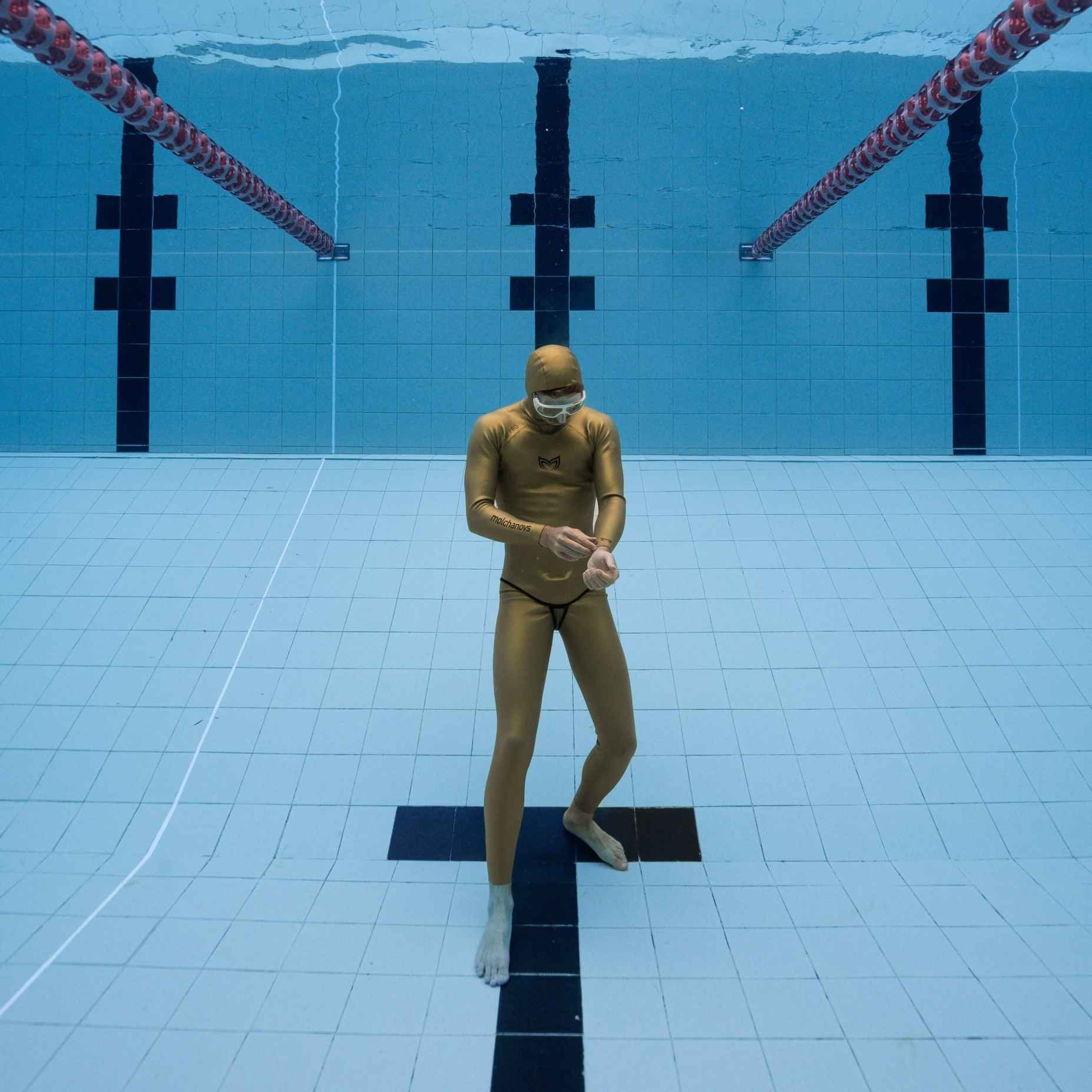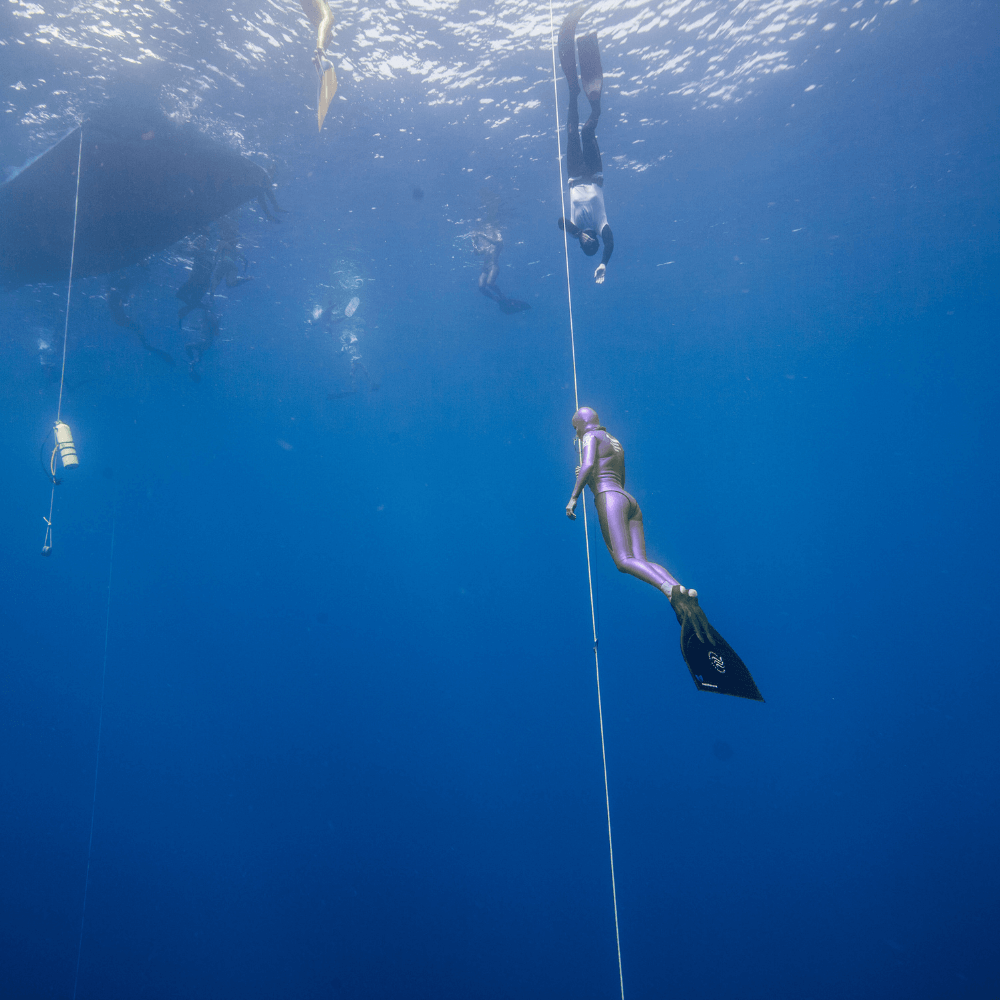Home / Latest / How to Find Your Perfect First Freediving Mask and Snorkel

A mask and snorkel are the bare minimum you need to explore the world of freediving. They’re also the most important. If you go diving with a foggy or leaky mask, or have a bulky snorkel strapped to your head, it will affect your comfort, relaxation, and ultimately your breath-holds!
That’s why you’ll want to spend extra time to find the mask and snorkel that’s just right for you. Keep reading to find out what makes certain masks and snorkels freediving-specific, why they’re not usually interchangeable with scuba/snorkeling equipment, and how to find the perfect mask fit.
First, there are a few basic specifics you need to know about what makes certain masks fit for freediving:

The good news is that while scuba masks aren’t great to use for freediving, freediving masks can be used for scuba!
Check it out:
1. Flip the strap of the mask to the front and out of your way.
2. Look up.
3. Place the mask on your face without wiggling or pushing.
4. Have a friend check if there are any gaps between your face and the mask. You can also verify this by inhaling through your nose and seeing if the mask sticks to your face when you tilt your head back to a neutral position.
5. Make sure that you can equalize with the mask on and verify that your fingers have easy access to your nose.


Let’s explore what to look for in a freediving snorkel:
To try them before buying, check if there's a Molchanovs dealer near you!
Want to stay updated on the latest gear launches from Molchanovs? Subscribe to our newsletter for the latest news.
How to Find Your Perfect First Freediving Mask and Snorkel
While masks and snorkels may be the cheapest equipment in your freediving gear bag, they’re also the most important. But with so many options, how do you choose the right ones?
Masks and snorkels are the most essential equipment for any freediver. Photo © Andac Kazar
A mask and snorkel are the bare minimum you need to explore the world of freediving. They’re also the most important. If you go diving with a foggy or leaky mask, or have a bulky snorkel strapped to your head, it will affect your comfort, relaxation, and ultimately your breath-holds!
That’s why you’ll want to spend extra time to find the mask and snorkel that’s just right for you. Keep reading to find out what makes certain masks and snorkels freediving-specific, why they’re not usually interchangeable with scuba/snorkeling equipment, and how to find the perfect mask fit.
Freediving Mask Features
Freediving masks are your eyes to the underwater world; they can either make your dives easier or become an uncomfortable barrier between you and the pool or ocean!First, there are a few basic specifics you need to know about what makes certain masks fit for freediving:
- Enclosed nose: You’ll need to be able to equalize the mask space as you dive down–something you can only do with your nose.
- Low volume: Less volume means you won’t have to equalize the mask space as often.
- Soft silicone skirt: A rigid “skirt” would hurt when the mask starts compressing on your face–silicone is flexible and more comfortable.
- Clear lenses: While colored reflective lenses may look cool, your buddy needs to see your eyes clearly to look for signs of trouble.
- Soft nose pocket: You should easily be able to pinch your nose and equalize, not dig around trying to find the perfect position.

Dive in style, but always look out for visibility, comfort, and nose pocket fit when choosing a freediving mask.
Photo © Mirela Kardasevic
Can’t you just use a scuba mask for freediving?
The short answer: It’s not recommended. Scuba masks and freediving masks might look the same at first glance, but scuba masks have larger volumes (and are much bulkier) than their freediving counterparts. So while you technically can use a scuba mask for freediving in a pinch, you’ll be equalizing your mask more often and sacrificing some hydrodynamics.The good news is that while scuba masks aren’t great to use for freediving, freediving masks can be used for scuba!
How To Check For A Perfect Mask Fit
It’s always a good idea to try new equipment out before buying; luckily, you can get a pretty good idea of mask fit on dry land!Check it out:
1. Flip the strap of the mask to the front and out of your way.
2. Look up.
3. Place the mask on your face without wiggling or pushing.
4. Have a friend check if there are any gaps between your face and the mask. You can also verify this by inhaling through your nose and seeing if the mask sticks to your face when you tilt your head back to a neutral position.
5. Make sure that you can equalize with the mask on and verify that your fingers have easy access to your nose.

Low volume, a snug fit, and high performance: The Molchanovs CORE Freediving Mask is perfect for freedivers of any level.
Extra Tips for Freediving Masks
Here are a few tips to keep in mind with your mask:- Spitting in your mask and rubbing it around makes for the most natural, ocean-friendly defogger.
- Glass masks may need to have toothpaste rubbed into the inner lens for 5 minutes to remove the clear protective barrier placed there by the factory–otherwise, no amount of spit will defog that mask for long.
- Plastic masks should not be treated with toothpaste–they don’t contain the protective barrier and are easily scratched.
- Plastic masks need extra care: When transporting one, make sure to carry it in a case and keep it safe from knocking or rubbing against other equipment.

A snorkel is essential for every freediver. It allows you to breathe on the surface. Photo © Andac Kazar
Selecting The Perfect Freediving Snorkel
Freediving snorkels and snorkeling snorkels are most definitely not created equal. However, just like with scuba masks, you can use freediving snorkels for scuba or snorkeling!Let’s explore what to look for in a freediving snorkel:
- Compact and low-volume: The less “dead air” trapped inside the snorkel tube, the better for your breath-hold.
- Made of flexible materials like silicone: It shouldn’t feel uncomfortable being strapped to the side of your head for an entire session.
- No purge valves or splash guards: This means less “dead air” and drag in the water.
- Comfortable mouthpiece: It should be soft enough that you can bite on it for a while without your jaw getting tired.
Molchanovs Freediving Mask and Snorkel
If you haven't found your perfect freediving mask and snorkel yet, you've come to the right place–Molchanovs offers a mask and snorkel that checks all the boxes. For a freediving mask with all of the features mentioned above, check out the CORE Freediving Mask. Plastic lenses and a curved frame give you a larger field of vision, paired with a sleek design and plenty of color combinations to choose from. The CORE Freediving Snorkel is also flexible, comfortable, and has a simple design.To try them before buying, check if there's a Molchanovs dealer near you!
Want to stay updated on the latest gear launches from Molchanovs? Subscribe to our newsletter for the latest news.



